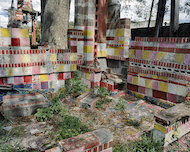The mindset that lives at the base of the so-called American Dream is that hard work and opportunity go hand in hand. And even with all the visible faults and mistakes that decorate our past and present, people from all over the world, from all different kinds of backgrounds and circumstances, still want to come here, hoping to leave behind the constraints and traumas of their own lives and to start fresh in a place where they can have a chance at something better. This tenaciously persistent risk-taking optimism is a large part of what defines the country and drives America forward.
But in the past few decades, large swaths of Americans have worked extremely hard but have failed to feel that classic American Dream momentum; in fact, they have stagnated. They work low paying jobs, struggle to pay bills and support families, and have grown increasingly frustrated with the rhythms of their lives. Opportunistic politicians like Donald Trump have tapped into this stubborn economic and psychological malaise, pitting these predominantly white, rural families against others (immigrants, city dwellers, the government itself) who they might see as threats, interlopers, or simply those that would talk down to them and tell them what to do. A more polarized nation has emerged, supported by the dangerous tendency to see stereotypes and exaggerations of our fellow citizens (on both sides), without really looking or trying to understand.
Numerous contemporary photographers have taken up the challenge of patiently spending time in more overlooked parts of the country, in search of the pulse of what is really happening. And of course, the realities (and frustrations) of life in California are subtly different than those in Texas, the South, or the Pacific Northwest, simply based on the predominant local conditions. Struggle, weariness, and decay take many forms, from sea to shining sea.
Curran Hatleberg has been probing this misunderstood vein of America with understated attentiveness for a number of years now. His 2017 gallery show (reviewed here) offered a glimpse of the beginnings of this project, and this new show delivers the matching bookend that signals its end (a fuller monograph of the body of work is scheduled to be published by TBW Books in 2022.) And while many of the images in the first edit were centered on groups and layers of people, these photographs leave the people out entirely, letting us see the moods and details of the surrounding environment more clearly.
Several of Hatleberg’s compositions show us rotting houses and buildings, the overwhelmed exhaustion of the American moment reflected in boarded up windows, sprawling insulation, peeling paint, and a torn screen door appropriated by a dog for easy entry and exit. And while we have seen plenty of American ruins before, Hatleberg’s intimate frames seem less voyeuristic than most. He sees the contrast between the sharp sides of a triangular house and the creeping natural growth threatening to overrun it. He notices the dappled light that falls across brightly painted (but seemingly abandoned) cinder block walls, the patterns of hard and soft intermingling with layered interlocked grace. And he gently examines the overstuffed mess of a cluttered kitchen, the moldy walls and empty cupboards attesting to lives led on the margins, with few options and even less motivation to clean up the growing pile in the center of the room. Even the departing dog seems to comment on the haltingly dejected situation, leaving behind the structural elements of the porch upended by a skewed thermometer, the water stained plywood, and a single dining chair left alone.
Some of the strongest photographs in the show offer reptiles as their subjects, bringing an edge of surreal wildness to the proceedings. A photograph of a huge snake taking a bath, in a tile cracked bathtub, with the shower pouring down and the baby shampoo ready on the edge, feels altogether feral but also strangely tender, while the dark curve of an alligator tail in a murky swamp is much less friendly, the proximity to muddy white boots making the implicit danger all too near. And an image of a fork lift driver hoisting up the bloody carcass of an alligator is the most striking, the hung verticality of the beast matched by the blocked verticals of the machinery; a second tail in the foreground alludes to yet more gators caught and killed, the war between man and nature (or civilization and chaos) seemingly devolving with each passing day.
Two smaller images offer offsetting glimmers of potential positivity. One discovers a thin rainbow reaching skyward from the sign of a seen-its-better-days marine equipment store on an otherwise cloudy day on some forgettable American Main Street, the vacant lot in the foreground dampened by rain but faintly reflecting the arc of brightness. And the other seems to have been shot out the front windshield of Hatleberg’s car, capturing the orange glow of a dramatic sunset as it settles into twilight over the traffic lights in the distance. Both pictures offer the ominous metaphors of dark skies and wet ground, but then balance those gloomy despairs with just a bit of elevating beauty.
With the completion of this strong project, and the Lost Coast work that preceded it (reviewed here), Hatleberg is steadily and methodically building a notable photographic career. The images on view here are consistently understated, honest, and perceptive rather than judgmental, and have been photographically crafted with obvious talent and maturity. Each photograph offers much more than a first glance typically reveals, with small details, textures, color stories, and compositional echoes emerging only after we’ve been looking awhile. This visual richness isn’t an accident – it’s the mark of a sophisticated eye, that takes in the available American desperation and re-envisions it in ways that draw us into its complexities and nuances.

